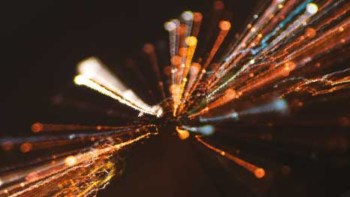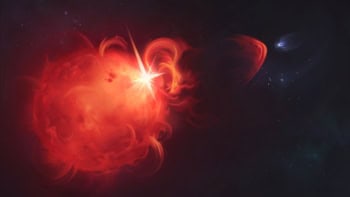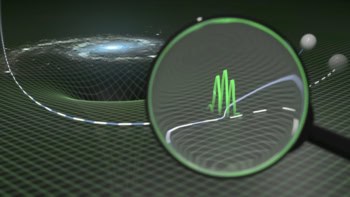Due to come online later this year and packed with state-of-the-art optics, Advanced LIGO is aiming for a direct detection of gravitational waves that will open a new window on the universe, say Iain Martin, GariLynn Billingsley and Gregory Harry

Imagine you were to measure the distance between the Earth and the Sun so precisely that you could observe changes in their separation equivalent to just a single atomic radius. As challenging as it sounds, this degree of precision is currently being realized at several sites across the globe in the search for gravitational waves. Predicted by Einstein’s general theory of relativity a century ago and generated by the acceleration of mass, these fluctuations in the curvature of space–time are so weak that only the most extreme astronomical systems – pulsars, supernovae, neutron stars and black holes – can produce a detectable signal.
Waiting to catch them is a series of “long-baseline” gravitational-wave detectors: LIGO in Lousiana and Washington State, US; Virgo in Italy; GEO600 in Germany; and the KAGRA detector under construction in Japan. The first-generation LIGO detectors began operation in 2001 and several runs have been carried out since then, most in conjunction with GEO600 and many with Virgo and TAMA – the predecessor of KAGRA in Japan.
Indirect evidence
Although no direct detection has been made, we have excellent indirect evidence for the existence of gravitational waves. The orbital period of the binary pulsar PSR 1913+16, for instance, is decaying at precisely the rate predicted by models of gravitational-wave emission. A direct discovery of these space–time ripples would not only remove any remaining doubt, but also usher a new era of gravitational-wave astronomy. This is the source of great excitement for a second generation of detectors – in particular an upgraded version of LIGO seven years in the making – that are due to come online starting this year.
As a gravitational wave propagates, it alternatively compresses and stretches space–time and exerts tidal forces on objects in its path. Long-baseline detectors search for these effects using laser interferometry to measure changes in the separation of test masses located at the ends of two long, perpendicular arms. (In LIGO, which is the largest of the long-baseline detectors, the arms are 4 km long and the test masses weigh 40 kg apiece.) A beamsplitter divides the laser light into two components and directs them along the arms to be reflected from the mirrored surfaces of the test masses, after which the reflected light is recombined to produce an interference pattern. Since a passing gravitational wave would increase the length of one arm relative to the other, it would cause a detectable change in the interference pattern.
To achieve the fantastically high sensitivity required to detect such minute displacements, a range of noise sources must be combatted. Seismic noise arising from the motion of the ground is reduced by suspending the mirrors by glass fibres, for example, while thermally induced vibrations in the mirrors and suspension fibres is another key noise source in low to mid-range frequencies. Seismic waves also cause “gravity gradient noise” – a direct gravitational force on the mirrors that effectively excludes searching for gravitational waves at frequencies below about 1 Hz.
In addition, quantum noise arising from radiation pressure at lower frequencies and photoelectron “shot noise” at higher frequencies combine to form what is known as the standard quantum limit. Advanced techniques for surpassing the standard quantum limit, such as “squeezed light” or speed-meter interferometry, may be implemented in future LIGO upgrades.
Following their initial operational period, a programme of upgrades to the LIGO and Virgo detectors was initiated in 2010. The Advanced LIGO (aLIGO) interferometers are now being commissioned, while the Advanced Virgo detector is in the final stages of construction. GEO600, meanwhile, has been used to test cutting-edge techniques and to provide cover in case a large gravitational-wave event occurs while the other detectors are offline. KAGRA is being built in a mine under Mount Kamioka in Japan to reduce seismic and gravity-gradient noise. Taken together, all of these widely separated detectors can operate as a network in order to pinpoint the source of any detected gravitational waves.
Thanks to upgrades to all the interferometer subsystems in LIGO – including a 200 W laser for improved shot noise, larger optics, improved optical coatings and silica suspension fibres, and more aggressive vibration isolation – the aLIGO detectors are designed to be 10 times more sensitive to gravitational waves than in the past. This translates to a rise in the expected event rate by a factor of 1000, leading to optimism that aLIGO will make a first detection of gravitational waves in an early observation run some time between now and 2020.
While this will be a momentous event, the ultimate goal is to make “gravitational-wave astronomy” a mainstream tool. The weak nature of gravity means that gravitational waves, unlike electromagnetic waves, are not readily scattered or absorbed. In addition to offering new insights into the physics of supernovae, neutron stars and black holes, gravitational-wave astronomy could therefore reveal information about the early universe and let us explore unknown astronomical objects that are massive but do not emit light, such as dark matter.
Optics challenge
Meeting aLIGO’s strict specifications has required state-of-the-art optics. At its heart are the interferometer mirrors, which must exhibit low thermal noise, high reflectivity and ultra-low optical loss. Thermal noise can be cut by using materials with a low mechanical loss: just as a good wine glass will ring with a pure note when tapped, so a gravitational-wave detector must be stable against thermal noise that causes the optics to vibrate. Careful design of aLIGO and the use of low-loss materials such as fused silica allow thermal noise to be low enough to detect gravitational waves.

To allow sufficient light power to build up in the arm cavities, which magnifies the gravitational-wave signal and reduces shot noise at high frequencies, highly reflective optical coatings made from multiple layers of dielectric materials were applied to the front of the mirrors. Unfortunately, these coatings typically have a mechanical loss several orders of magnitude higher than the fused-silica-mirror substrate, resulting in thermal noise that limits aLIGO’s performance at its most sensitive frequencies. Understanding these issues has been a crucial part of the R&D for aLIGO and potential further upgrades.
In addition, the mirror coatings must also have exceptional optical performance so that high levels of power can build up in the interferometer arm-cavities and minimize thermal distortions in the mirrors. Extraordinary levels of optical absorption lower than 0.5 parts per million (ppm) and less than 2 ppm of the incident light scattered have been achieved for aLIGO.
Construction and installation of aLIGO began in 2008 and finished in March this year. Most of the $205m price tag has been paid for by the US National Science Foundation, with Australia, Germany and the UK contributing $30m. Some 10% of the overall budget has been devoted to aLIGO’s test masses, beamsplitters and other core optical components. Heraeus in Germany provided the silica glass; Tinsley did the shaping and polishing; and Laboratoire des Matériaux Avancés and the Commonwealth Scientific and Industrial Research Organization did the coating.
The first optical components were delivered to the LIGO Louisiana site in early 2012 and it took a few months to instal them. The first step was to weld the test mass to the silica suspension fibres. Each one is supported by four fibres, which at their narrowest point are only 0.4 mm in diameter. The entire cartridge of suspension, optic and seismic isolation was then lowered into a vacuum chamber by a crane, where technicians aligned the optics in situ.
There are still challenges with charge build-up on the mirrors, for instance, because their positions are controlled via electrostatic actuators, and also with mechanical excitation of the installed optics. However, none of these issues has changed the expectation that aLIGO will have the sensitivity to detect a gravitational wave.
In 2016 aLIGO will be joined by Advanced Virgo, followed by KAGRA in 2018 and a possible third aLIGO detector in India in 2022. Thanks to this truly international effort, there is a growing sense that a direct detection of a gravitational wave is on the horizon – one that may just chime with the centenary of Einstein’s prediction.



